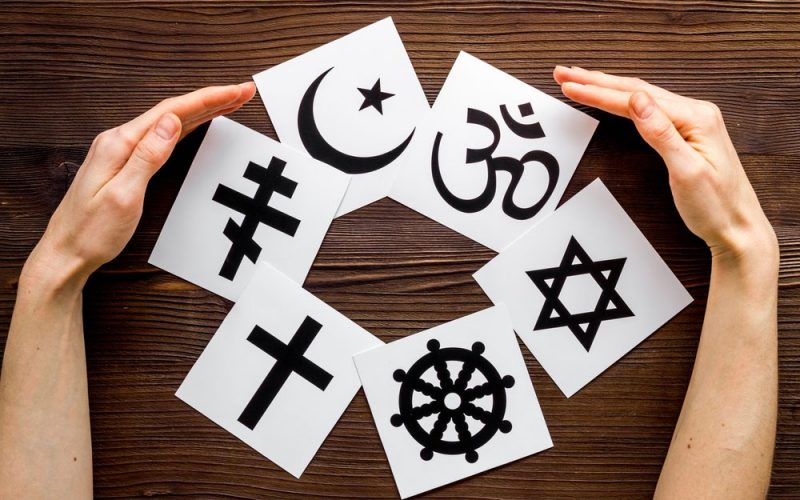The conventional wisdom is that religion is the realm of the irrational (in a good or a bad sense, depending on one’s point of view), and as such, it can’t be studied in the way that other aspects of human behavior are studied. While all of social science is based on the idea that human behavior is essentially explainable, it makes no sense to exclude a major and apparently constant behavior like religion-building from what should be studied scientifically. The sources of religious experience may well be mysterious, irrational, and highly personal, but religion itself is not. It is a social rather than a psychological phenomenon, and, in the absence of active repression, it unfolds according to observable rules of group behavior.
RELIGION AND STRIFE

Religion —Islam, Christianity, Judaism, Hinduism, or any other religion— is not about peace. Nor is it about war. Every religion is about absolute belief in its own superiority and the divine right to impose itself upon others. In medieval times, both the Crusades and the Jihads were soaked in blood. Today, Christian fundamentalists attack abortion clinics in the US and kill doctors; Muslim fundamentalists wage their sectarian wars against each other; Jewish settlers holding the Old Testament in one hand, and Uzis in the other, burn olive orchards and drive Palestinians off their ancestral land; Hindus in India demolish ancient mosques and burn down churches; Sri Lankan Buddhists slaughter Tamil separatists.
DEVELOPMENT OF RELIGION

The best expression I’ve found of the evolutionary dynamics of religions comes in William James’s Varieties of Religious Experience. It’s worth quoting. “A genuine first-hand religious experience,” he writes, “is bound to be a heterodoxy to its witnesses, the prophet appearing as a mere lonely madman. If his doctrine proves contagious enough to spread to any others, it becomes a definite and labeled heresy. But if it then still proves contagious enough to triumph over persecution, it becomes itself an orthodoxy; and when a religion has become an orthodoxy, its day of inwardness is over: the spring is dry; the faithful live at second hand exclusively and stone the prophets in their turn. The new church, in spite of whatever human goodness it may foster, can be henceforth counted on as a staunch ally in every attempt to stifle the spontaneous religious spirit, and to stop all later bubblings of the fountain
from which, in purer days, it drew its own supply of inspiration.”
RELIGIOUS KALEIDOSCOPE
It’s tempting to conceive of the religious world—particularly when there is so much talk of clashing civilizations—as being made up primarily of a few well-delineated and static religious blocs: Christians, Jews, Muslims, Buddhists, Hindus, and so on. But that’s dangerously simplistic. It assumes a stability in the religious landscape that is completely at odds with reality. New religions are born all the time. Old ones transform themselves dramatically. Schism, evolution, death, and rebirth are the norm. And this doesn’t apply only to religious groups that one often hears referred to as cults. Today hundreds of widely divergent forms of Christianity are practiced around the world. Islam is usually talked about in monolithic terms (or, at most, in terms of the Shia-Sunni divide), but one almost never hears about the 50 million or so members of the Naqshabandiya order of Sufi Islam, which is strong in Central Asia and India, or about the more than 20 million members of various schismatic Muslim groups around the world. Think, too, about the strange rise and fall of the Taliban. Buddhism, far from being an all-encompassing glow radiating benignly out of the East, is a vast family of religions made up of more than 200 distinct bodies, many of which don’t see eye-to-eye at all. Major strands of Hinduism were profoundly reshaped in the nineteenth century, revealing strong Western and Christian influences. The implication is clear: what is now dismissed as a fundamentalist sect, a fanatical cult, or a mushy New Age fad could become the next big thing. The religions keep adapting themselves to new social ecosystems with an amazing alacrity.
When Martin Luther nailed his 95 theses upon the door of the Castle Church in Wittenberg, in 1517, he could hardly have imagined that he would succeed in spawning a new, Protestant branch of the Christian Church. He would also no doubt be surprised if he could see the direction Protestantism has taken in the past 500 years. What would Luther think if he were somehow to visit the state of Utah, essentially a homeland for the Mormon church—a movement born out of American Protestantism which is now one of the fastest growing movements in the country, with 5 million adherents in the U.S. alone and estimated assets of around 30 billion dollars? Or if he were to attend a service of the evangelist Toronto Blessing movement based in Canada, in which “a move of the Holy spirit” can lead to congregants barking like dogs, roaring like lions, and laughing uncontrollably?
The evolution of Protestantism is but a tiny example of the constant churning change taking place in the world of religion. And not only are established religions always mutating, but new ones are constantly being born. According to the World Christian Encyclopedia, an 800-page volume that attempts to track every religion practiced around the world, there are 9,900 distinct religions and two or three new religions created every day. A growing number of scholars are studying these new religious movements, or NRMs, concentrating on such questions as, what social conditions lead to the creation of new religions. How, exactly, do religions mutate? What was it about early Christianity or Islam or Buddhism that made those movements survive, when most new religions fail?
NEW RELIGIOUS MOVEMENTS

Initial converts to just about any religious movement, new or old, tend to feel pretty euphoric about the new community they’ve become a part of, and that sort of feeling is remarkably similar from movement to movement. What’s often particular to new movements, though, at least to successful ones, is a sense of being involved in a community that is ideologically and spiritually at odds with the surrounding society. Scholars of new movements generally seem to agree that for a new movement to succeed, it has to define itself against the status quo and be very demanding of its members. Movements that just allow people to come and go, without a lot of commitment and sacrifice, tend to fail pretty quickly. So in a lot of new movements there is probably a bit of a siege mentality, which, of course, is exactly the sort of bonding experience that people often are in search of when they choose their religion.
It’s often said that new religious movements do well because they are so small and can therefore adapt to changing social environments very quickly. As that new social environment settles down and becomes established, so do the religious movements that grew up along side it. It’s interesting to note that India’s “untouchables,” now known as Dalits, have regularly flirted in recent years with the idea of a mass conversion out of Hinduism and into another religion, notably Christianity. If tensions became severe between the Dalits and Indian culture at large, it’s not inconceivable that such a conversion could take place, which would suddenly make Christianity a sort of new religious movement among millions of people. Context is everything.
It does seem that the initial membership of new movements is often dominated by the young, the well educated, and the affluent. I suppose this probably has something to do with the facts that the young like new things that get their parents upset; that more education generally leads to an openness to new ideas; and that affluence often leads to a sort of selfishness and materialism that can suddenly seem appallingly corrupt to those who have grown up in it. But in the end what really draws people in to new movements is that they offer, as one scholar put it, a “high octane” brand of religion. It’s kind of a thrill, just as attending an African-American gospel service might be for a Catholic. There’s a vitality and passion there that just makes an emotional connection. Rodney Stark tries to disabuse his readers of the idea that somehow there’s something that you meaningfully might call “theological refinement” in religion; his point is that if a religion becomes an intellectual pursuit, full of abstract and metaphorical notions about spirituality, and loses touch with the passion and zeal and self-sacrifice that created the original movement, it’s lost. The same thing goes for music, come to think of it—new, less-refined versions of it are born all the time, and these versions have a cult-like appeal, especially to the young, the affluent, and the well educated. The same standard of success applies, too: the Beatles were a deviant cult until they became successful, which meant soon enough that the Queen knighted them and new musical movements emerged that emulated them—or even rejected them. So at root what draws people to new religious movements is that high-octane sense of passion and community. And what keeps them there is pretty much the same everywhere, too, —the simple and obvious fact that they work, in terms of how they allow individuals to function in society. The African example is a good one. New religious movements, particularly Christian ones, are extraordinarily popular in Africa, and that this is in large part due to the fact that these movements are now trans-national. A lot of Africans have to be very mobile in search of work, and these new trans-national movements allow them to feel at home and part of a larger community whether they’re in Ghana or Botswana.
It is also not fair to say that these new movements can’t succeed very well unless they are politically persecuted in their early stages. One theory has it that Christianity survived and thrived in the Roman Empire because initially it was considered just too marginal to pay much attention to. There was the occasional Christian thrown to the lions or something, but in the larger picture—which at the time involved all sorts of cults and movements from all over the Roman Empire—Christianity just didn’t seem like much of a political threat. Rodney Stark cites the strength of a religious “free market” in order to explain the odd paradox that the United States is a pretty fervently religious country even though its constitution explicitly sets up a wall between religion and politics.
FROM CULT TO RELIGION

One of the debates that continually roil the study of new religious movements is whether a distinction can really be made between cults and new religions—after all, many of today’s established religious movements began on the fringes of society. One thing is clear, though—a couple of hundred years from now, our religious landscape will look radically different than it does now. All sorts of developments are possible. Catholicism might evolve into a distinctly Charismatic movement rooted primarily in China and headed by an African pope…. Membership of the Mormon Church might become predominantly Latin American or Asian. Scientology might become the informal state religion of California…. None of these possibilities is as unlikely as it may sound. One has a tendency to think that today’s major world religions—Islam, Judaism, Christianity, Buddhism, Hinduism—are just fixed elements of the religious firmament, but that’s not the case at all, of course. Go back just a few thousand years, just a blip in human history, and none of those religions existed. And think of the fates of, say, Zeus, Odin, and Ahuramazda, all gods who at one point or another in history lots of people felt were absolutely essential to the course of human events. If one can find this sort of flux in history who is to say that other equally important and influential religions can’t still emerge?
In fact there is as much religious flux now as there ever has been. The Mormons, for example, have only been around for a century and a half but already they’re on the verge of becoming a world religion with millions of adherents and all sorts of cultural and political influence—even though in the nineteenth century they were regularly persecuted as an aberrant, blasphemous, and extremely dangerous cult. Ralph Waldo Emerson called Mormonism an “after-clap of Puritanism,” the irony of which is hard to miss at a time when the Mormons essentially hosted the Olympic Games and the Unitarians are only found in small pockets here and there around the country. Pentecostals at the turn of the twentieth century were laughed at as bizarre “holy rollers,” but now it seems that in the current Pentecostals around the world may number as many as one billion. In countries like Nigeria, they hold congregations involving up to two million participants. Falun Gong is another movement that has emerged almost imperceptibly, from the Western perspective, as a huge force in the world. In Islam, the past few decades have witnessed Ahmadi sect thriving at a very robust speed.
One would be surprised to discover just how much religious activity there is in the world. This does not just mean how many people describe themselves as religious, which is the usual indicator that people discuss, or how many people pray or go to churches or mosques or temples, at least, once a week.
A cult is a cult until it becomes successful. At that point it becomes a religion. People who study new religions observe that as religions become more successful, they gradually develop an orthodox structure and an internal hierarchy and a relatively low-tension relationship with society, all of which means that their initial cult-like feeling fades away. For example, to most Romans, Christianity seemed like just a weird cult of blood drinkers and cross worshipers—a “depraved, excessive superstition,” as Pliny the Younger put it. What made Christianity succeed, in large measure, though, was its protean nature—it was able to find a place for itself in Roman culture, and then in other cultures, in the process transforming itself pretty dramatically. What would a second-century Christian think, say, of a Californian megachurch? Or a Latin American Pentecostal congregation? And vice versa? Which would be the cult?
WHAT MAKES A RELIGION SUCCESSFUL

The success of one religion versus others involves all sorts of factors, including the charisma of the founder, the social environment and the political system into which the religion is introduced, and a lot of pure chance. The sociologist Rodney Stark, in 1996 wrote an article in the Journal of Contemporary Religion called “Why Religious Movements Succeed or Fail.” He listed ten factors that he felt are essential to a religion’s success, some of which I can try quickly to summarize here. 1) Cultural continuity with the society at large. Mormonism has succeeded, for example, because of how much it emphasizes the heritage it shares with Christianity. 2) They exist at a moderate level of tension with society—they’re “strict, but not too strict,” Stark says. 3) They can create a highly motivated group of volunteers who gladly will work for the community and many of whom will actively proselytize. 4) They have enough children to keep membership strong, and they work at keeping their children engaged in the religion. 5) They seek out an open “market niche,” as it were, and exploit it well. 6) They exist in a political climate that is at least somewhat tolerant of religious unorthodoxy. Stark goes on at much greater length and in much greater detail, but those are some of the things he thinks are pretty important. Obviously a charismatic leader is crucial at the outset, too, but charisma alone won’t do it—to succeed a movement quickly has to give itself a structure and an identity that is both strong and adaptable.
A religion helps people survive, in all of the ways that people need to survive—social, spiritual, economic, finding a mate. The religion has to be able to forge a community to create broad trans-ethnic and trans-national communities, so that when somebody moves from city to city or country to country there’s a sort of surrogate family structure in place.
Success is really about relationships and not about faith. What happens is that people form relationships and only then come to embrace a religion. It doesn’t happen the other way around. That’s really critical, and it’s something that one can only learn by going out and watching people convert to new movements. One can only observe this while studying the development of NRMs. You can never find that sort of thing out after the fact—because after the fact people do think it’s about faith. And they’re not lying.
The religion has to give people things to do. The folks in the Vineyard are geniuses at that. It’s quite an adventure to go off somewhere and set up a new church for them. The Mormons are great at giving people things to do too. They not only tithe money but they also tithe time. They do an enormous amount of social services for one another, all of which builds community bonds. It also gives you this incredible sense of security—I’m going to be okay when I’m in a position of need; there are going to be people to look out for me. That makes a difference. And if you want to build commitment, send your kids out on missions when they’re nineteen! Go out and you save the world for two years! Even if you don’t get a single convert, it’s worth it in terms of the bonds you develop.
A religion also got to have a serious conception of God and the supernatural to succeed. Just having some ‘essence of goodness,’ like the Tao, isn’t going to do it. It just isn’t. It doesn’t even do it in Asian countries. They hang a whole collection of supernatural beings around these essences. So to succeed you do best by starting with a very active God who’s virtuous and makes demands, because people have a tendency to value religions on the basis of cost.
There is another phenomenon that is very relevant to the free and modern world of the North today. That is, in an environment of religious freedom people choose to develop and maintain their religious beliefs in accordance with the laws of a “religious economy.” The essence of the idea is this: People act rationally in choosing their religion. If they are believers, they make a constant cost-benefit analysis, consciously or unconsciously, about what form of religion to practice. Religious beliefs and practices make up the product that is on sale in the market, and current and potential followers are the consumers. In a free-market religious economy there is a healthy abundance of choice (religious pluralism), which leads naturally to vigorous competition and efficient supply (new and old religious movements). The more competition there is, the higher the level of consumption. This would explain the often remarked paradox that the United States is one of the most religious countries in the world despite also being one of the strongest enforcers of a separation between Church and State.
Where do Muslims stand today? Islam, like all other major religions, carries very different meaning to different people. It is as heterogeneous as those who believe and practice it. There is no one “true Islam”. Therefore it only makes sense to speak of people who claim that faith.
The idea of Islam as an unchanging monolith is a very misleading one. Islam is full of variety and schism and factionalism—which is another way of saying it’s still full of life, notwithstanding the contemporary focus on the static and uncompromising vision of bin Laden and his crew. It is very certain that Islam will play a major role in the world for centuries to come. What’s interesting, actually, is to think of groups like the Muslim Brotherhood and the Taliban as new religious movements themselves—each one emerged in the twentieth century, after all. If they conform to what scholars have learned about the emergence and evolution of new movements, either they will wither away or they will become more and more mainstream, which will mean that they will evolve ways of more peacefully coexisting with society. And if they enjoy a measure of success in the meantime, perhaps that will lead to a pendulum swing toward new movements in Islam. There have been recent reports, for example, that Sufism is undergoing a bit of a revival. The Ahmadi movement, which is only about two centuries old, claims to have millions of members, and seems to have global reach. Right now the groups suffers considerable persecution and is banned from making the pilgrimage to Mecca, but one could make the case that the Ahmadis are a bit like Islamic Mormons, practicing a divergent yet culturally continuous brand of religion—and that precisely because of that, and despite the “heresy” of their new beliefs, they have a reasonable chance of success, at least in the religious free market.
The writer is the author of four books that can be seen at https://www.amazon.com/Asif-Zaidi/e/B07J2S7R11







